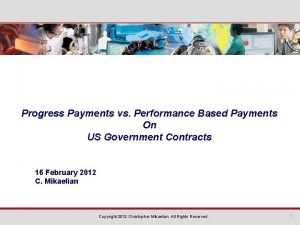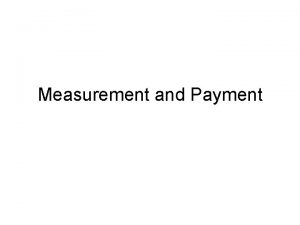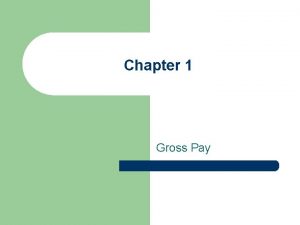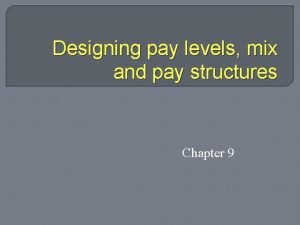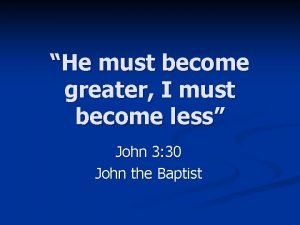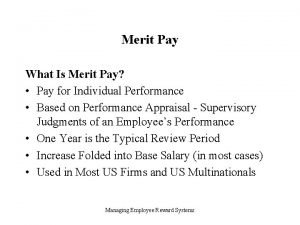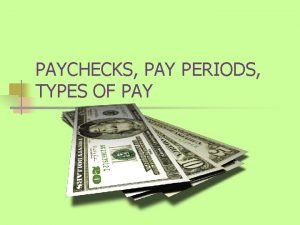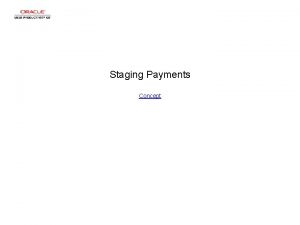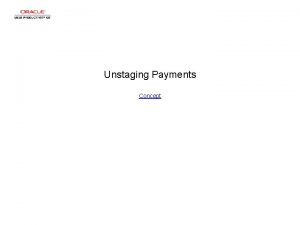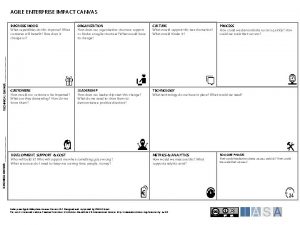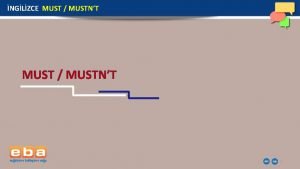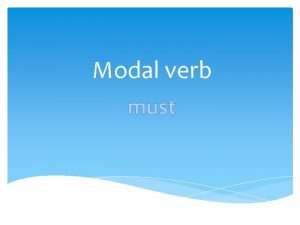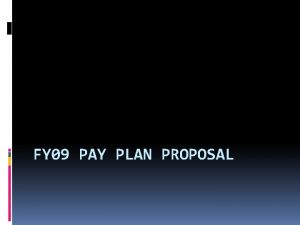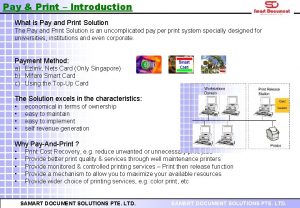Progress Payments Progress Payments Owner must pay for

























- Slides: 25

Progress Payments

Progress Payments – Owner must pay for work – GC & Subs must prepare invoices for work done • Contract Types – Way payments are handled is based on contract type – Most contracts • Request for payment submitted to owner monthly • Progress payment is made during following month • GC must have enough cash to keep project running

Cost Plus & GMP – PM requests payment based on actual expenses • Must have invoices from Subs and Suppliers – PM submits invoices and GC payroll to owner – Impossible to overbill – Fees & lump sum items billed using schedule of values & % complete – PM may be audited by owner

• Lump Sum – Based on % complete & schedule of values – Front loading and overbilling can occur • Unit Pricing – Paid based on quantities installed – Can be subjective • Time & Materials – Paid on actual labor hours and labor rate plus materials costs based on supplier invoice

• Measurement for Payment – Certain measurements do not represent true pay quantities • Pipeline paid for by amount shown on drawing • Drawing shows horizontal distance not length of pipeline on grade • Does not include pipe overlap (bell & spigot joint) • Contractor must take this into account when bidding job • RPR must know how to measure bid item

• Rock and Earth Quantities – Compacted earth takes up less area than earth in natural state (shrinkage) • shrinkage depends on material and compaction methods • Fine Sand 6%, Sand Gravel 8%, Ordinary Clay 10%, Loam 12%, Surface Soil 15% – Rock takes up more space when removed (swell) from ground

• A/E and contractor should agree on a method of measuring material and use it throughout project • Truckloads of loose material – Water content can change weight of load – 10% WC = 500 lbs extra / 10 ton load – Pay for materials in place as calculated from dimensions shown on the plans • Must be careful on a unit price bid to make sure contractor is not over excavating to use more material.

• Paving Quantities – Small differences in depth can make a huge difference in price – 0. 5” over a 12’ lane 1 mile long = 2200# – Also need to make sure that asphalt is at temperature when spread

Measurement Guidelines for Unit Price Quantities • Pipelines – depend on contract can be horizontal distance (drawings), measures along top of joined pipe – Do not measure along side of pipe • Curbs – top edge facing the street • Channels – use same location in channel for each measurement • Sewer Lines – measure edge of manhole to edge of manhole – manholes separate item

• Fencing – horizontal or along top rail of fence • Pavements – area but watch for underruns on pavement thickness • Retaining walls – each wall is measured as a prism, where walls meet do not double count

Schedule of Values • Agreed upon breakdown of contract cost – Must be agreed upon before first progress payment – Based on estimate and buyout values – Usually tied to activities or CSI Division – F 15 -1 – Should be reasonably detailed – GC can frontload fees into early pay items • Not good practice

• Fee on Cost plus can be based on – % complete • When project 60% done fee should be 60% paid – Actual costs incurred • More up front to cover start up costs – Straight line equal payments each month

• Change Orders – Approved change orders can be paid as separate line items or spread over schedule of values

Payment Request Process • Payment Request usually at end of month – PM must gather invoices from subs and suppliers & GC costs for submittal to A/E firm – Subs & Suppliers must have their invoices to PM by 20 th of month • Subs & suppliers must estimate work and materials that will be completed by end of month – Only pay for materials that are on site – If stored off site must be in bonded facility • PM must estimate GC work to end of month

Payment Request Process – PM then creates schedule of value with work completed – F 15 -2 – Draft submitted to owner and A/E firm for approval by 25 th • Allows for changes before end of month – A/E approves request F 15 -3

Cash as a Tool • A contractor with a reputation for paying subs and suppliers fast and fairly may get a better price on the bid – Just as GC does not have huge capital neither do subs and suppliers • Must pay in a timely manner – Discounts for early payment to suppliers • Whoever pays gets discount

Lien Management – Suppliers use materialman’s notice F 15 -4 – Lien releases F 15 -6 • Subs and suppliers will hold a lien on the property until paid in full • Conditional lien releases are signed every month to release that part of the project that is being paid for except retention • Unconditional Lien Releases are a final release of all rights to place a lien on the property by a sub, supplier or GC – Signed after final payment

Retention • Money held back until project is completed and approved – Usually 5 – 10 % – Withheld monthly – Early subcontractors should be paid off 30 days after they are done • Helps with their finances

• Retainage – 5 – 10% of contract price – Gives owner $ to satisfy lien claims if GC does not pay – Also is the profit – Can do either a lump sum or it can be computed based on each months progress payments

– Retainage given to GC 35 days after completion of work if – all lien releases turned in – All employees paid – Approval of the performance insurance CO. – GC gets all but the amount representing the value of uncompleted or substandard work or materials.

• Liquidated Damages during construction – Can have liquidated damages for missed milestones • Throws other contractors behind • Deduct from next progress payment

• Unbalanced Bids – Contractor raises prices on some items and lowers prices on others w/o changing total project cost – Should be rejected if found

• Why do unbalanced bids – To discourage certain types of construction and encourage others that the Contractor is good at – Contractor thinks A/E estimate is low can make unit price high and make extra profit – Increase unit prices on first items of work to be completed => receive excessive early payments then default on the job • Leaves Surety with too little $ to do job

• Can build up working capital – eliminates squeeze due to 10% retention • Detecting an Unbalanced Bid – Usually an unbalanced bid indicates and A/E error in estimate – Use a spreadsheet to compare bids to find wide swings in bid prices • All contractor’s should be in the same price range if normal bid

• Resolving an Unbalanced Bid – Easiest way is to reject all bids (owner’s perogative) – Take bids to A/E point out area where possible error exists in estimate – Get a new estimate – Rebid job
 Performance based payments vs progress payments
Performance based payments vs progress payments Progress payments construction
Progress payments construction Section 1-1 1-2 hourly pay and overtime pay answers
Section 1-1 1-2 hourly pay and overtime pay answers How much does wanda earn per hour?
How much does wanda earn per hour? Designing pay structure
Designing pay structure Short term incentive
Short term incentive Physical progress and financial progress
Physical progress and financial progress He must become more i must become less
He must become more i must become less Tobinskatten för och nackdelar
Tobinskatten för och nackdelar Vad är referatmarkeringar
Vad är referatmarkeringar Varför kallas perioden 1918-1939 för mellankrigstiden
Varför kallas perioden 1918-1939 för mellankrigstiden Lågenergihus nyproduktion
Lågenergihus nyproduktion Karttecken höjdkurva
Karttecken höjdkurva Meios steg för steg
Meios steg för steg Rbk fuktmätning
Rbk fuktmätning Lufttryck formel
Lufttryck formel Elektronik för barn
Elektronik för barn Vad är densitet
Vad är densitet Tack för att ni har lyssnat
Tack för att ni har lyssnat Smärtskolan kunskap för livet
Smärtskolan kunskap för livet Frgar
Frgar Vad är ett minoritetsspråk
Vad är ett minoritetsspråk Typiska novell drag
Typiska novell drag Mjälthilus
Mjälthilus Uppställning multiplikation
Uppställning multiplikation För och nackdelar med firo
För och nackdelar med firo
